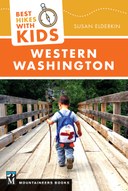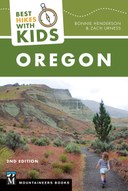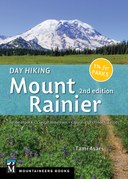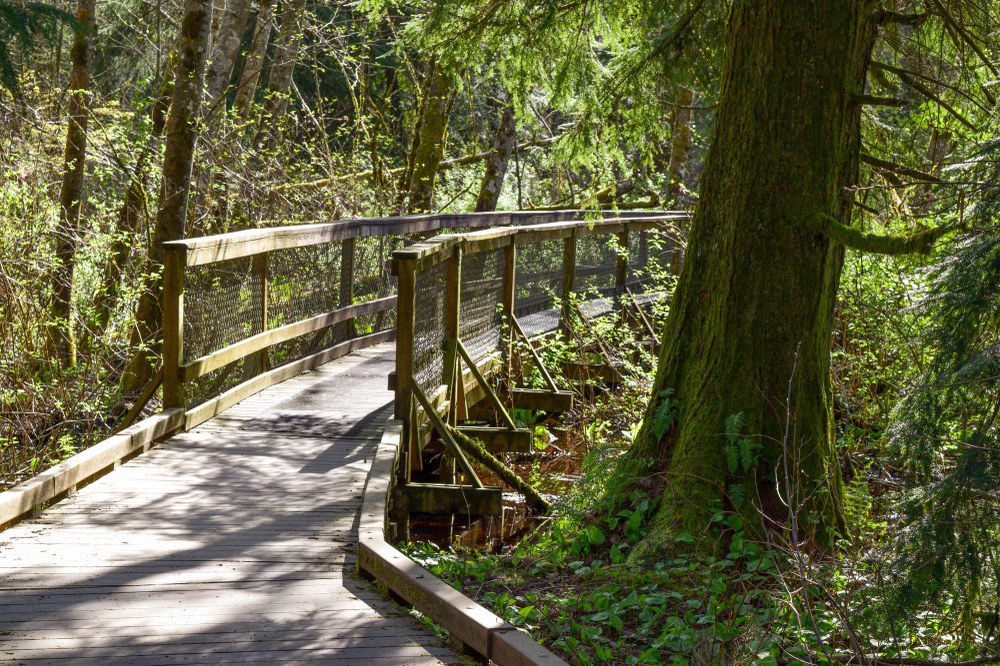
We sat down with Susan Elderkin to find out her favorite area hikes for young children from her new book Best Hikes with Kids: Western Washington. The following are kid-tested and kid-approved, to help you get your kids out and exploring nature at any age!
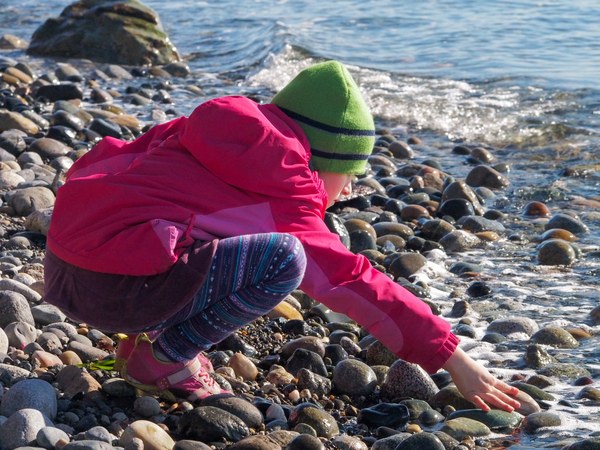
Point Whitehorn Marine Reserve in Bellingham
1.6 miles roundtrip with 75’ elevation gain, and a year-round hiking destination
A wheelchair-accessible trail winds through wetlands and upland forest to a bluff with views out across the Strait of Georgia to a dozen San Juan Islands, including Orcas, Lummi, Cyprus, and Sucia. Stairs to the cobblestone beach below offer opportunities to baskin its south-facing sun and dip bare feet into the chilly waters. The preservation of this sweet 54-acre tract is owed to a series of deft and creative land transactions by the Whatcom Land Trust in the early 2000s, which protects this habitat near the heavy industrial footprint of the Cherry Point Refinery.
Start your hike at the sign located in the middle of the parking area. Because it is a designated marine reserve, dogs are not allowed. The trail is wide enough to walk side by side and suitable for strollers. Interpretive signs add context for kids.
The forest includes a variety of native conifers like Douglas fir, Sitka spruce, western hemlock, and western red cedar. It’s also boggy, but your way is dry thanks to a series of small bridges and boardwalks. Soon the conifers give way to deciduous forest of black cottonwood, big-leaf maple, and more. Emerging from the forest, the trail travels along the bluff for a short distance, with three overlooks graced by lovely, polished stone benches at 0.75 mile.
This is where strollers must stop, but hikers can proceed 75 feet down the steep bluff and stairs to the beach. When the tide is low, you can explore and investigate tide pools (please step lightly and leave all marine life where you see it).
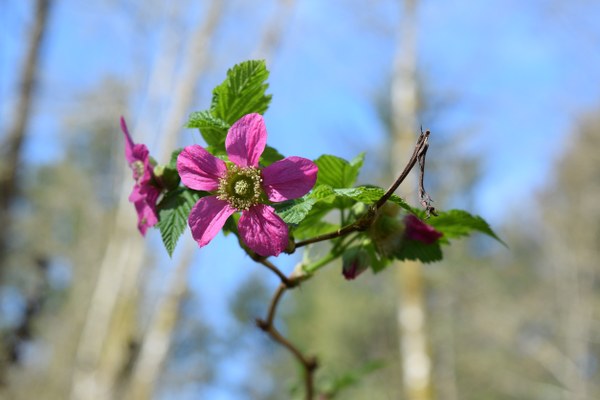
The West Hylebos Wetlands in Federal Way
1.4 mile loop with 25’ elevation gain, and a year-round hiking option
The West Hylebos Wetlands is one of those surprising places—a thriving oasis of green tucked away in a busy suburban area. Here, birds sing and frogs croak. Moss, lichen, and ferns attach to nearly every surface. Water oozes from the ground, flows, and pools. Very old trees, plus two historic cabins, give visitors a sense that they are entering a world of yesteryear. And a level boardwalk sweeps through it all, making it an ideal destination for feet and strollers (sorry, bikes and dogs are not allowed).
This is one of the last, and largest, remaining peat bogs in South King County. The spongy soil is 30 feet deep in places and supports a diverse array of plants and animals—from tiny fungi and shy garter snakes to a Sitka spruce more than four hundred years old. Begin your walk at the two historic cabins adjacent to the parking lot. These buildings date to the 1880s, but they didn’t originate here. The distinctive Denny Cabin once housed a real estate office on Queen Anne Hill in Seattle, and the Barker Cabin sat a few miles away from this spot. Take time to peer inside and read the signs.
A wide crushed gravel pathway curves gently downhill, past a picnic area, about 0.2 mile to the beginning of the boardwalk. Shortly thereafter, reach a junction. The trail runs in a loop, and the interpretive signs tell a more logical story if you take it clockwise. Make sure to stop and read the first sign on the loop, which depicts the different kinds of wetlands you’ll encounter—the younger scrub shrub and the older forested wetlands—then look for the transitions during your walk.
The trail visits a few interesting nooks and crannies. The first is called the “deep sink,” a hole that used to be 20 feet deep, but is now filling in with mud and vegetation. Follow the boardwalk above the squishy wetlands, and at 0.5 mile reach an ancient Sitka spruce that’s 175 tall, but leaning rather precariously. A curious, large, carved wooden mushroom sits to the side of the trail.
At 0.7 mile, take the short detour to Brooklake. It’s just 500 feet, and worth the effort to walk over the swampiest part of the trail and to gaze at the lovely reflections on the lake. Take a seat on a bench and soak up the peacefulness of this place. Return to the junction, going straight, and then meander 0.2 mile back to where you first began your circuit. Turn left, and return up the gravel pathway to the parking area. Make sure to return in a different season to see how the wetlands change.
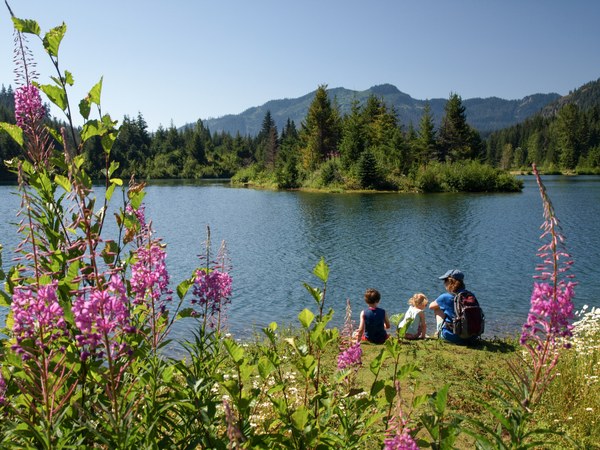
Gold Creek Pond at Snoqualmie Pass
1.4 mile loop with 25’ elevation gain, and a May to October hiking option
My favorite toddler hike in the I-90 corridor is Gold Creek Pond. Even the smallest tykes feel confident striding on a level paved pathway and wooden boardwalks. Older children and adults will appreciate the pretty mountain views reflected in a tranquil pond. This is an excellent choice for one of those foggy Puget Sound summer days; you could shiver in the June gloom, but why not drive up Snoqualmie Pass and bask beyond the clouds in some summer sun?
Take the paved path to the left of the privy, soon coming to the loop trail. Head to the right, allowing the pond to slowly reveal itself. Travel alongside a babbling creek, through willows, flowers, and a young forest. You may notice that some terrain looks sculpted. In the 1970s and ’80s, this quiet place was a gravel pit, serving the construction of Interstate 90. Huge cranes hoisted gravel into dump trucks until there was no more. In 1983, Washington Department of Transportation, in conjunction with the US Forest Service, began transforming this site into fish and wildlife habitat. I’ve been coming here for a decade, and each year the foliage looks wilder and more natural.
At 0.5 mile, reach a junction. The trail to the right takes hikers on a moderate ascent up the Gold Creek watershed. Continue left for the pond, just now coming into view, with clouds, trees, and mountains reflected brightly on its teal-colored surface. Below the boardwalk is a lush, marshy environment filled with ocean spray, bleeding hearts, yellow violets, and ferns.
Because this trail is so short, we have always slowed down to savor it. I’ve let the kids throw rocks into the water below the bridge, inspect the shaggy moss in the creek that feeds the pond, and come up with names for the two small islands in the water. At 0.7 mile is a side trail. Take it! A little peninsula of green pushes far out into the pond, allowing kids the feeling of being in the center of a lake among jumping fish and skittering water bugs.
Having stretched out time as much as possible, press onward. At 1.1 mile, reach an expansive picnic area, complete with grills. The only thing it doesn’t have is shade. If you’re not spreading out a feast, cross over the creek again and head back to the trailhead.
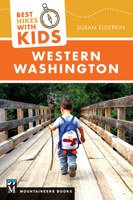 Excerpted from Best Hikes With Kids: Western Washington (Mountaineers Books, April 2018) by Susan Elderkin. To discover more great hikes for the whole family, make sure to pick up your copy today.
Excerpted from Best Hikes With Kids: Western Washington (Mountaineers Books, April 2018) by Susan Elderkin. To discover more great hikes for the whole family, make sure to pick up your copy today.
 Susan Elderkin
Susan Elderkin
